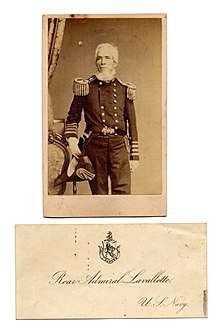Elie A. F. La Vallette
Elie Augustus Frederick La Vallette (3 May 1790 – 18 November 1862) was one of the first rear admirals appointed in the United States Navy when Congress created the rank in July 1862.[1]
Elie Augustus Frederick La Vallette | |
|---|---|
 Rear Admiral La Vallette | |
| Born | May 3, 1790 Alexandria, Virginia, U.S. |
| Died | November 18, 1862 (aged 72) Philadelphia Naval Yard Hospital, U.S. |
| Allegiance | |
| Service/ | |
| Years of service | 1812–1862 |
| Rank | |
| Commands held | USS Despatch USS Fairfield USS Independence USS Congress Africa Squadron Mediterranean Squadron |
| Battles/wars | War of 1812 Mexican–American War |
La Vallette was born in Alexandria, Virginia, to a distinguished family of French origin,[2] and at the age of 10 accompanied his father, a chaplain, on a cruise in the frigate Philadelphia, commanded by Stephen Decatur, Sr.[1]
After serving the merchant marine, La Vallette entered the Navy[1] on June 25, 1812, as sailing master.[3] On September 11, 1814, he was an acting lieutenant aboard the corvette Saratoga, the flagship of Commodore Thomas Macdonough at the Battle of Lake Champlain, where the British were defeated in a decisive engagement of the War of 1812.[2] La Vallette distinguished himself during the battle, winning promotion and a medal.[1] He received his commission as lieutenant on December 9, 1814.[3]
La Vallette's first command came in June 1817, taking the schooner Despatch on a survey of Virginia's coast and harbors. He then served on a number of larger ships, and in 1824 was assigned to Constitution. While on duty in the Mediterranean, he was acting captain for several months, and served on the ship until 1828.[2]
After leaving Constitution, La Vallette held a series of routine assignments, before being ordered to take the sloop-of-war Fairfield to Guayaquil, Ecuador, to protect the United States interests during a revolution. He sailed from the United States in May 1833, rounding Cape Horn, and finally reaching Guayaquil in February 1834. After receiving assurances that American lives and property would be protected, he returned home, making the voyage from Valparaíso to Hampton Roads in a little more than two months.[2]
He formally anglicized his name to Lavallette in 1830.[2] Lavallette was promoted to master commandant on March 3, 1831,[3] and to captain on February 23, 1840.[3]
During the Mexican–American War (1846–1848) Lavallette commanded the frigates Independence and the Congress,[2] directing operations against Guaymas in the Gulf of California on 19–20 November 1847.[1] For a time in 1848, he served as Military Governor of Mazatlán, and the crew of the Congress comprised the occupying garrison.[2] In the 1850s he commanded the Africa and Mediterranean Squadrons.[1]
On 30 July 1862, President Abraham Lincoln appointed Lavallette a rear admiral on the retired list.[2] Four months later, on 18 November,[1] Rear Admiral Lavallette died at the Philadelphia Naval Yard Hospital.[2] He is buried in Laurel Hill Cemetery, Section W-122&124.[4]
Two destroyers of the United States Navy have been named USS La Vallette for him.
The Borough of Lavallette, New Jersey was named in his honor and was co-founded by his son Albert T. Lavallette.[5]
References
- "La Vallette". Dictionary of American Naval Fighting Ships. Navy Department, Naval History and Heritage Command. Retrieved 1 September 2010.
- "Rear Admiral Elie A.F. La Vallette, USN (1790–1862)". destroyerhistory.org. Archived from the original on 8 February 2011. Retrieved 1 September 2010.
- "US Navy Officers: 1775-1900 (L)". history.navy.mil. Archived from the original on 23 June 2006. Retrieved 1 September 2010.
- "Elie Augustus Frederick Lavalette". www.findagrave.com. Retrieved 14 July 2020.
- "Lavallette, New Jersey". lavallette.com. Archived from the original on July 3, 2007. Retrieved July 19, 2007.
- This article incorporates text from the public domain Dictionary of American Naval Fighting Ships. The entry can be found here.